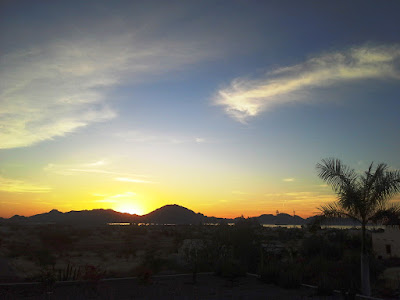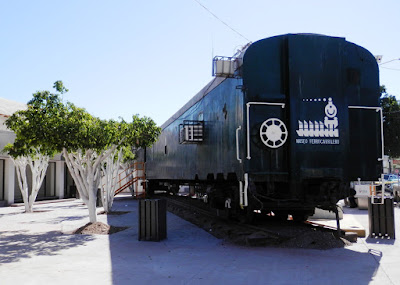Time flies and it is February! And...we are still focused on boat projects. And...we extended our stay at the rental apartment to ensure we have time and space to sort, organize and hopefully locate some of our elusive spare parts. We have not given up on hoping to cruise - optimistic the remaining tasks will come together with greater speed and less need to order parts.
 |
| Tinkerbelle |
Yesterday dawned grey and overcast - what a difference after all the glorious sunrises and blue skies. At the boat, Carol measured and adjusted the 'in the works' hand rail covers to protect our newly cleaned teak rails. Kelly searched for, among other items, the spare raw water impellers. Changing the oil is on the to do list and inserting a new impeller is part of the task. We chatted with folks on the dock and were entertained by our exuberant neighbour Tinkerbelle as she enjoyed the opportunity to stretch her legs along Dock A.
A day for errands. We checked out the other Ferreteria (hardware) store in town, looking at alternatives to PVC pipe as possible coverings for the exterior teak when INTREPID II is on the hard. Then on to Ruth and Rudy's Bakery; this time we are looking forward to a vegetarian "Mexican Lasagna" made with squash blossoms which Ruth only makes a few times a year. Of course, banana bread and pecan tarts somehow made their way into our bag as well. A few minutes in the Castaway Kids thrift store just to see what was new. By then it was as well past lunch time - so a good reason to stop in at the outdoor seafood spot for tacos
camarones (shrimp); and purchase a bundle of asparagus from the lady selling fresh produce on the corner.
 |
| One of the local water supply stores |
On to the the purified water store - we rely on refilling the large containers called "
garafons", on a regular basis, for drinking water. You purchase the plastic containers (we had one supplied at our rental), then have them rinsed and refilled at a purified water outlet, which uses a reverse osmosis process. We pay 15 pesos ($1.05) to fill a 5 gallon
garafon. The water is effectively de-mineralized, so we often drink a brand of bottled carbonated mineral water called "Topo Chico" A small bottle costs 13.50 pesos for 20 fluid ounces - what a difference. We truly wish recycling was an option here as it is often difficult to minimize the use of plastic.
And finally, a stop at CI Banco, the one and only bank currently in San Carlos. There is often a lineup to use the ATMs; yesterday only one was working. These machines have both Spanish and English on the digital display, so the process is quite straightforward. We do pay a tax for using the machine - a fee of 15 pesos plus the 16% IVA Tax on the 15 peso charge - a total of 17.4 pesos.
That evening we treated ourselves to dinner at Tortuga's restaurant - bar side. A bit of a wait for our meals, but that gave us time to enjoy listening to the featured musician, Lorena Robles, who had a very attentive audience. We first heard her singing and playing guitar years ago at Palapa Greiga and were pleased to have another opportunity. According to her profile, Lorena sings in seven languages, and was trained in classical guitar and operatic singing. A relaxing evening and we now have a CD to revisit her performance.
 |
| Lorena Robles |
















































